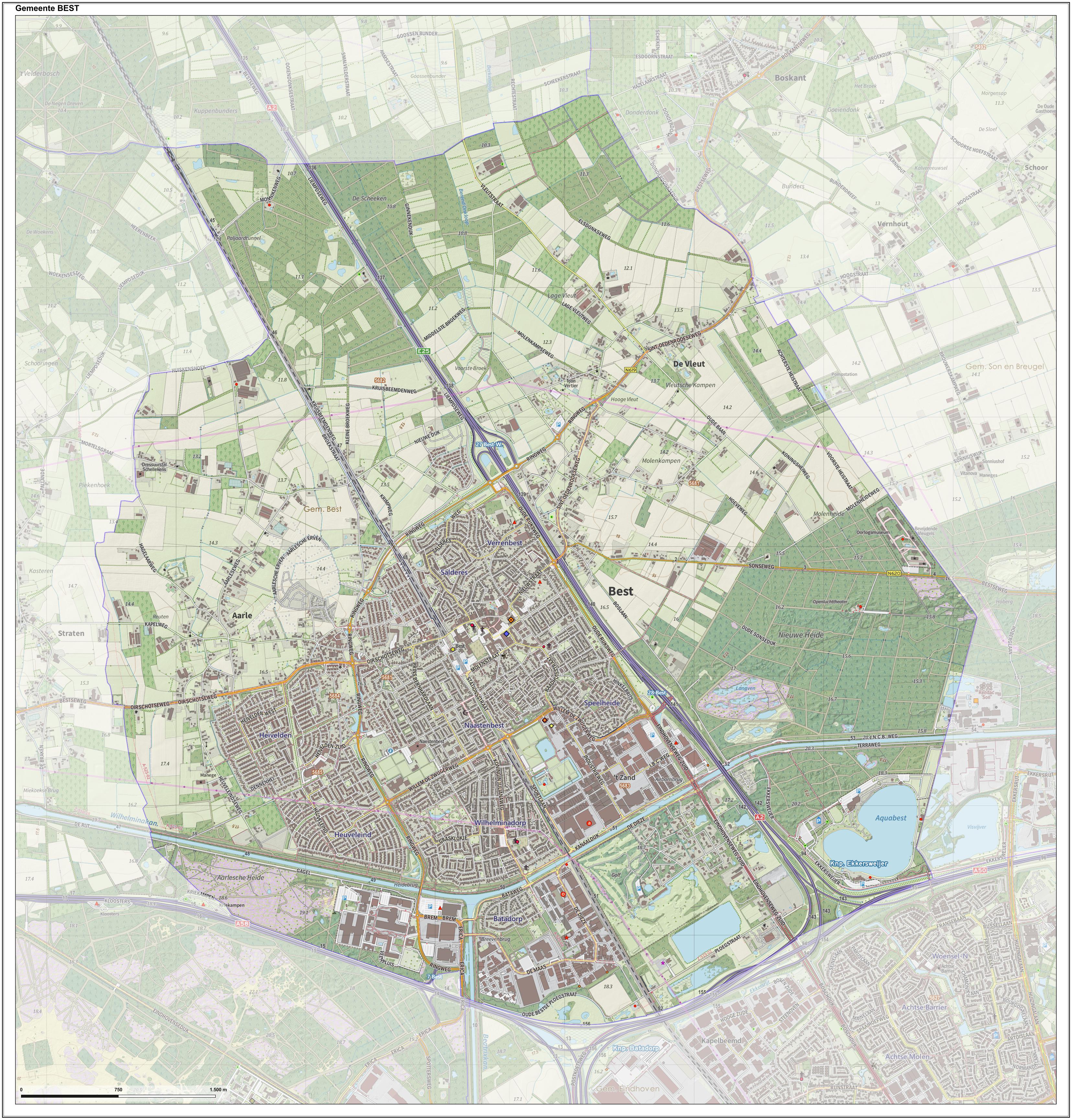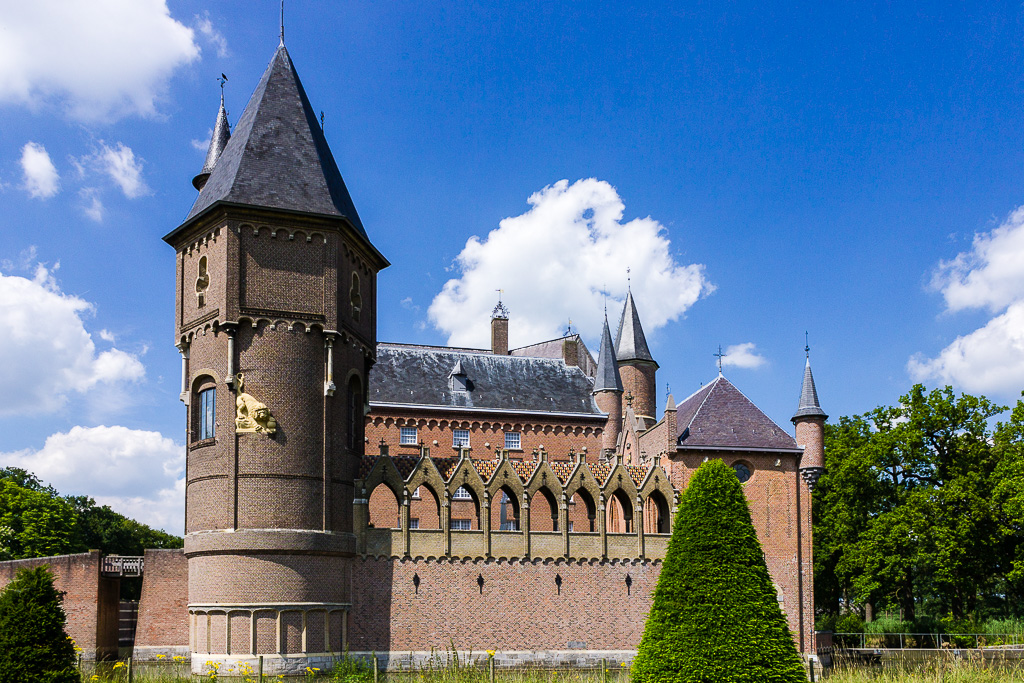|
Armenhoef
The Armenhoef is a monumental farm on the Oirschotseweg 117 in the North Brabantian town Best in the Netherlands. The Armenhoef is the oldest, still in use farm of North Western Europe. By archaeological building research in 2009 the timber frame of the barn was determined to date back to 1263. The modern farmhouse itself dates to different periods (see final two paragraphs). The farm is a monument and was in urgent need of restoration. The government was prepared to provide a contribution to this restoration. Also, the building has been recognized as a monument. This deviates from state policy not to designate buildings dating from the period before 1940 as a national monument. The name of the farm has to do with the former function. Armenhoef means Poor People Farm. The proceeds of this then-largest farm in Best were used for poor aid. The municipality has recognized the building as a municipal monument because of its cultural, historical, architectural and scenic value. Elemen ... [...More Info...] [...Related Items...] OR: [Wikipedia] [Google] [Baidu] |
Best, Netherlands
Best () is a municipality and a village in the southern Netherlands. It is situated northwest of the city Eindhoven, and is also part of the agglomeration of this city. The headquarters of Europe's largest meat processor Vion NV are located in Best, as are Philips Healthcare and the Bata Shoe Organization's "Bata Protective" operations (B2B). History The village used to be a part of Oirschot, a nearby town. But as Best was situated on the state road from Amsterdam to Maastricht, this often created difficulties. Each time the military wanted to quarter troops in Best, they had to request to be stationed in Oirschot, 10 km away, for this to be allowed. Because of this difficulty, the government decided to separate Best from Oirschot in 1819. Archaeological excavations around the village suggest settlement in the area dating back to the Roman era. The Armenhoef is a monumental farm on the Oirschotseweg 117 in Best. This stable is the oldest still in use within Western Europe. ... [...More Info...] [...Related Items...] OR: [Wikipedia] [Google] [Baidu] |
North Brabant
North Brabant ( nl, Noord-Brabant ; Brabantian: ; ), also unofficially called Brabant, is a province in the south of the Netherlands. It borders the provinces of South Holland and Gelderland to the north, Limburg to the east, Zeeland to the west, and the Flemish provinces of Antwerp and Limburg to the south. The northern border follows the Meuse westward to its mouth in the Hollands Diep strait, part of the Rhine–Meuse–Scheldt delta. North Brabant has a population of 2,562,566 as of November 2019. Major cities in North Brabant are Eindhoven (pop. 231,642), Tilburg (pop. 217,259), Breda (pop. 183,873) and its provincial capital 's-Hertogenbosch (pop. 154,205). History The Duchy of Brabant was a state of the Holy Roman Empire established in 1183 or 1190. It developed from the Landgraviate of Brabant and formed the heart of the historic Low Countries, part of the Burgundian Netherlands from 1430 and of the Habsburg Netherlands from 1482, until it was split up after th ... [...More Info...] [...Related Items...] OR: [Wikipedia] [Google] [Baidu] |
Netherlands
) , anthem = ( en, "William of Nassau") , image_map = , map_caption = , subdivision_type = Sovereign state , subdivision_name = Kingdom of the Netherlands , established_title = Before independence , established_date = Spanish Netherlands , established_title2 = Act of Abjuration , established_date2 = 26 July 1581 , established_title3 = Peace of Münster , established_date3 = 30 January 1648 , established_title4 = Kingdom established , established_date4 = 16 March 1815 , established_title5 = Liberation Day (Netherlands), Liberation Day , established_date5 = 5 May 1945 , established_title6 = Charter for the Kingdom of the Netherlands, Kingdom Charter , established_date6 = 15 December 1954 , established_title7 = Dissolution of the Netherlands Antilles, Caribbean reorganisation , established_date7 = 10 October 2010 , official_languages = Dutch language, Dutch , languages_type = Regional languages , languages_sub = yes , languages = , languages2_type = Reco ... [...More Info...] [...Related Items...] OR: [Wikipedia] [Google] [Baidu] |
Dendrochronology
Dendrochronology (or tree-ring dating) is the scientific method of dating tree rings (also called growth rings) to the exact year they were formed. As well as dating them, this can give data for dendroclimatology, the study of climate and atmospheric conditions during different periods in history from wood. Dendrochronology derives from Ancient Greek (), meaning "tree", (), meaning "time", and (), "the study of". Dendrochronology is useful for determining the precise age of samples, especially those that are too recent for radiocarbon dating, which always produces a range rather than an exact date. However, for a precise date of the death of the tree a full sample to the edge is needed, which most trimmed timber will not provide. It also gives data on the timing of events and rates of change in the environment (most prominently climate) and also in wood found in archaeology or works of art and architecture, such as old panel paintings. It is also used as a check in radiocar ... [...More Info...] [...Related Items...] OR: [Wikipedia] [Google] [Baidu] |
Radiocarbon Dating
Radiocarbon dating (also referred to as carbon dating or carbon-14 dating) is a method for determining the age of an object containing organic material by using the properties of radiocarbon, a radioactive isotope of carbon. The method was developed in the late 1940s at the University of Chicago by Willard Libby. It is based on the fact that radiocarbon () is constantly being created in the Earth's atmosphere by the interaction of cosmic rays with atmospheric nitrogen. The resulting combines with atmospheric oxygen to form radioactive carbon dioxide, which is incorporated into plants by photosynthesis; animals then acquire by eating the plants. When the animal or plant dies, it stops exchanging carbon with its environment, and thereafter the amount of it contains begins to decrease as the undergoes radioactive decay. Measuring the amount of in a sample from a dead plant or animal, such as a piece of wood or a fragment of bone, provides information that can be used to calc ... [...More Info...] [...Related Items...] OR: [Wikipedia] [Google] [Baidu] |
Bent (structural)
A bent in American English is a transverse rigid frame (or similar structures such as three-hinged arches). Historically, bents were a common way of making a timber frame; they are still often used for such, and are also seen in small steel-frame buildings, where the term portal frame is more commonly used. The term is also used for the cross-ways support structures in a trestle. In British English this assembly is called a "cross frame". The term ''bent'' is probably an archaic past tense of the verb ''to bind'', referring to the way the timbers of a bent are joined together. The Dutch word is ''bint'' (past participle ''gebint''), the West Frisian is , and the German is . Compare this with the term bend for a class of knots. Bents are the building blocks that define the overall shape and character of a structure. They do not have any sort of pre-defined configuration in the way that a Pratt truss does. Rather, bents are simply cross-sectional templates of structural members, i ... [...More Info...] [...Related Items...] OR: [Wikipedia] [Google] [Baidu] |
Foundation (engineering)
In engineering, a foundation is the element of a structure which connects it to the ground, transferring loads from the structure to the ground. Foundations are generally considered either shallow or deep. Foundation engineering is the application of soil mechanics and rock mechanics (geotechnical engineering) in the design of foundation elements of structures. Purpose Foundations provide the structure's stability from the ground: * To distribute the weight of the structure over a large area in order to avoid overloading the underlying soil (possibly causing unequal settlement). * To anchor the structure against natural forces including earthquakes, floods, droughts, frost heaves, tornadoes and wind. * To provide a level surface for construction. * To anchor the structure deeply into the ground, increasing its stability and preventing overloading. * To prevent lateral movements of the supported structure (in some cases). Requirements of a good foundation The design and the c ... [...More Info...] [...Related Items...] OR: [Wikipedia] [Google] [Baidu] |
The Netherlands
) , anthem = ( en, "William of Nassau") , image_map = , map_caption = , subdivision_type = Sovereign state , subdivision_name = Kingdom of the Netherlands , established_title = Before independence , established_date = Spanish Netherlands , established_title2 = Act of Abjuration , established_date2 = 26 July 1581 , established_title3 = Peace of Münster , established_date3 = 30 January 1648 , established_title4 = Kingdom established , established_date4 = 16 March 1815 , established_title5 = Liberation Day , established_date5 = 5 May 1945 , established_title6 = Kingdom Charter , established_date6 = 15 December 1954 , established_title7 = Caribbean reorganisation , established_date7 = 10 October 2010 , official_languages = Dutch , languages_type = Regional languages , languages_sub = yes , languages = , languages2_type = Recognised languages , languages2_sub = yes , languages2 = , demonym = Dutch , capital = Amsterdam , largest_city = capital , ... [...More Info...] [...Related Items...] OR: [Wikipedia] [Google] [Baidu] |
Northwestern Europe
Northwestern Europe, or Northwest Europe, is a loosely defined subregion of Europe, overlapping Northern and Western Europe. The region can be defined both geographically and ethnographically. Geographic definitions Geographically, Northwestern Europe usually consists of the United Kingdom, Ireland, Belgium, the Netherlands, Luxembourg, Northern France, Germany, Denmark, Norway, Sweden, and Iceland. Switzerland, Finland, and Austria are also often considered part of Northwestern Europe. Southern France is not regarded as northwestern, as it is usually geographically and culturally considered part of the Mediterranean region or Southern Europe. Ethnographic definitions Germanic languages are widely spoken in most of Northwestern Europe, although other languages are also present, including Romance languages in Northern France, Southern Belgium, Luxembourg, and some parts of Switzerland; Celtic languages along the western fringes of the British Isles and in Brittany; and Ur ... [...More Info...] [...Related Items...] OR: [Wikipedia] [Google] [Baidu] |
Brabant
Brabant is a traditional geographical region (or regions) in the Low Countries of Europe. It may refer to: Place names in Europe * London-Brabant Massif, a geological structure stretching from England to northern Germany Belgium * Province of Brabant, which in 1995 was split up into two provinces and an autonomous region: ** Flemish Brabant, in the Flanders region ** Walloon Brabant, in the Wallonia region ** Brussels-Capital Region * Klein-Brabant, the municipalities Bornem, Puurs and Sint-Amands in the Antwerp province of Flanders region * East Brabant, or Hageland, an area east of Brussels between the cities of Leuven, Aarschot, Diest and Tienen Netherlands * North Brabant province France * Brabant-en-Argonne, commune in the Meuse department * Brabant-le-Roi, commune in the Meuse department ** Brabant-lès-Villers (1973–1982), former commune, amalgamation of Brabant-le-Roi and Villers-aux-Vents Historical use * Pagus of Brabant, the original, early medieval territory, d ... [...More Info...] [...Related Items...] OR: [Wikipedia] [Google] [Baidu] |
Medieval Netherlands
In the history of Europe, the Middle Ages or medieval period lasted approximately from the late 5th to the late 15th centuries, similar to the Post-classical, post-classical period of World history (field), global history. It began with the fall of the Western Roman Empire and transitioned into the Renaissance and the Age of Discovery. The Middle Ages is the middle period of the three traditional divisions of Western history: classical antiquity, the medieval period, and the modern history, modern period. The medieval period is itself subdivided into the Early Middle Ages, Early, High Middle Ages, High, and Late Middle Ages. Population decline, counterurbanisation, the collapse of centralized authority, invasions, and mass migrations of tribes, which had begun in late antiquity, continued into the Early Middle Ages. The large-scale movements of the Migration Period, including various Germanic peoples, formed new kingdoms in what remained of the Western Roman Empire. In the ... [...More Info...] [...Related Items...] OR: [Wikipedia] [Google] [Baidu] |





